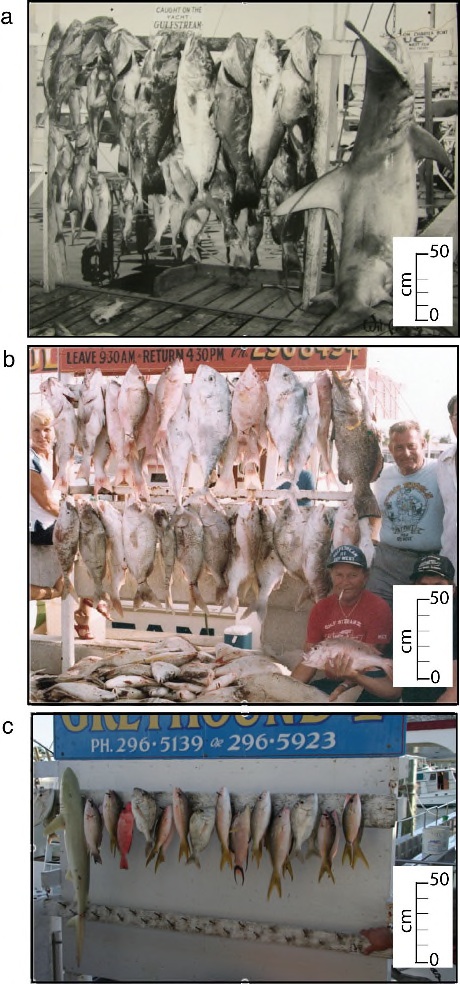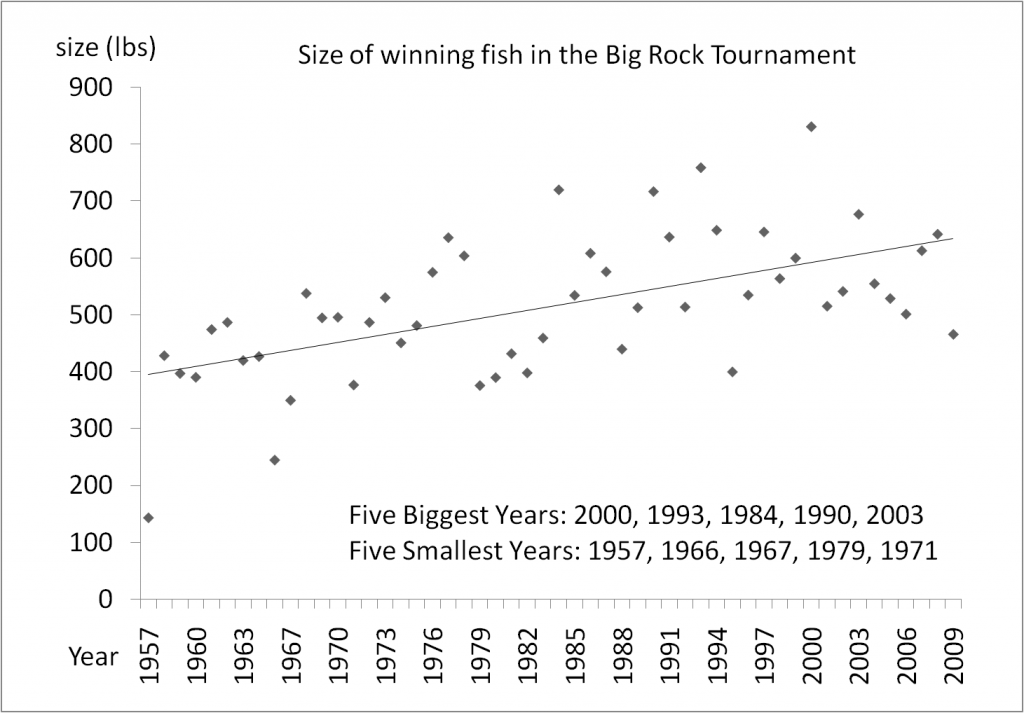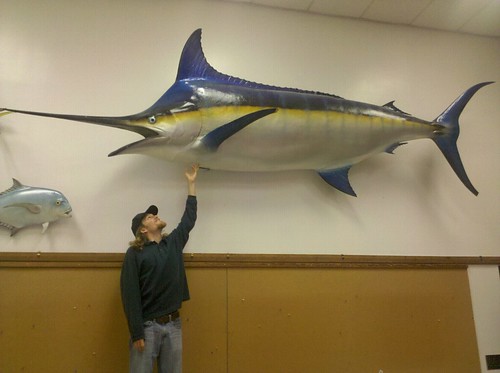
![]() This week’s ResearchBlogCast featured the paper “Decline in top predator body size and changing climate alter trophic structure in an oceanic ecosystem”, originally discussed at Fish Schooled (Prey populations explode as predators get smaller). In both the podcast and the blogpost, the authors argue that prey abundance booms despite predator biomass remaining constant because the average size of predatory fish is decreasing, a trend that has been describe as fisheries induced selection.
This week’s ResearchBlogCast featured the paper “Decline in top predator body size and changing climate alter trophic structure in an oceanic ecosystem”, originally discussed at Fish Schooled (Prey populations explode as predators get smaller). In both the podcast and the blogpost, the authors argue that prey abundance booms despite predator biomass remaining constant because the average size of predatory fish is decreasing, a trend that has been describe as fisheries induced selection.

The basic premise behind fisheries induced selection is that, since commercial fishing favors larger fish, there is a selective advantage to reproducing at smaller and smaller sizes. Fish that don’t reach sexual maturity before they reach commercial catch size will be removed from the gene pool. Fish that become sexually mature before they reach commercial catch size will reproduce more often, and their offspring will also mature sooner. This can result in the average size of commercial fish species decreasing over time, forcing fishermen to catch smaller fish, continuously increasing the selective pressure.
What this means is that historic declines in fish size are not just because “we’re catching all the big ones” but rather the biggest fish are actually smaller now than they were in the past. In the most severe cases, this can change the entire trophic structure of an ecosystem. Dominant predators suddenly become prey to non-commercial fish that used to be smaller than them, further reducing the population. It also means that just stopping fishing will not magically bring the big fish back.
During the podcast, Kevin Zelnio of Deep Sea News brought up the Big Rock Blue Marlin Tournament in Morehead City, North Carolina as an example of fish size decline. One of those common-wisdom type facts that gets often repeated in marine science circles is that in tournaments like Big Rock, the size of the trophy winning fish is declining. 50 years ago the fish used to be huge, now they’re barely big enough to qualify. I’m certainly guilty of making this statement, so the time was right to see if it’s true.
As it happens, Big Rock has been held every year since 1957 and the trophy weights are archived. So let’s take a look:
Wait, that can’t be right? According to this graph, the trophy size has actually been increasing over the years. The five smallest years were all before 1980 while the five biggest years were all after 1980. The last decade saw two of the biggest catches, including the heaviest on the books, a whooping 831 pounds. If fisheries induced selection is making fish smaller, why do the biggest marlin keep getting bigger?
I have a few hypotheses for this phenonmenon.
- Blue marlin are actually getting bigger. Blue marlin are game fish, but are not being fished commercially. On the other hand, their major competitors, including swordfish and several shark species are commercial fish. By removing their competitors, the blue marlin get a bigger portion of the prey. However, blue marlin also cannibalize when other prey is lean, so larger marlin are predators on smaller marlin. This gives the competitive advantage to the marlin that can grow the biggest the fastest – fisheries induced selection in the opposite direction.
- Recreational fishing is getting better. Modern recreational fishing boats have a greater range, depth finders, fish finders, radios and cell phones, and there are simply more of them. So the marlin are still in decline, but fishermen have gotten better at finding those last few big ones.
- Blue marlin are getting smaller and this graph is biased by selective sampling. The trend line is only weakly correlated to the data set (r-squared of 0.34) and this is not a representative sample of the size of blue marlins.
This is a life-size mount of the largest blue marlin caught in North Carolina at the time it was molded. The 1,142 pound blue marlin was caught in 1974, during the time that Big Rock catches were smallest. Clearly, there were big marlin alive during that time, so why weren’t they caught in the tournament? I think the simplest and most likely explanation is a combination of hypotheses 1 and 2. Blue marlin are not a commercial fishery, so there is less pressure on their populations, but fishing technology is also getting better, making it easier for fisherman to catch big marlin. Incidentally, the current record holder for North Carolina was caught in 2008, weighing in at a massive 1228 pounds.
So is the recreational blue marlin fishery sustainable? Well, probably not. One of the many arguments made by the commercial fishing industry is that commercial fishing will stop when it becomes too expensive to continue fishing. Barring other factors (such as political capital and nationalism in Japanese Whaling), the industry will crash before the last fish is caught. Recreational fishing does not have this restriction. It has always been expensive to fish for big game fish, and the profits generated are from commercial charters, not fish landings. The free market puts a higher value on the act of catching the fish than it puts on the actual fish. This means that cash flow is independent of fish caught.
In other words, the last Blue Marlin will be killed for fun.
~Southern Fried Scientist
Shackell, N., Frank, K., Fisher, J., Petrie, B., & Leggett, W. (2009). Decline in top predator body size and changing climate alter trophic structure in an oceanic ecosystem Proceedings of the Royal Society B: Biological Sciences, 277 (1686), 1353-1360 DOI: 10.1098/rspb.2009.1020
Jorgensen, C., Enberg, K., Dunlop, E., Arlinghaus, R., Boukal, D., Brander, K., Ernande, B., Gardmark, A., Johnston, F., Matsumura, S., Pardoe, H., Raab, K., Silva, A., Vainikka, A., Dieckmann, U., Heino, M., & Rijnsdorp, A. (2007). Ecology: Managing Evolving Fish Stocks Science, 318 (5854), 1247-1248 DOI: 10.1126/science.1148089
McCLENACHAN, L. (2009). Documenting Loss of Large Trophy Fish from the Florida Keys with Historical Photographs Conservation Biology, 23 (3), 636-643 DOI: 10.1111/j.1523-1739.2008.01152.x


I don’t know if genetic information supports this or not, but ICCAT currently manages all blue marlin in the Atlantic as a single stock, and after perusing some recent stock assessments (http://www.iccat.int/en/assess.htm), the stock is improving, though still classified as overfished. So assuming that they are, indeed, a single stock then they are potentially undergoing heavy enough fishing to see evolutionary effects. While some combination of 1&2 does seem like a reasonable explanation, it doesn’t rule out 3 in my opinion: this tournament probably occurs at about the same time every year, perhaps some accident of migration/prey availability is creating a strong drive for them to be near NC at that time of year?
Andrew –
Very interesting . . . .
So important to question simplistic notions. Even if we end up confirming those notions.
P.S. Love the title to your blog.
Thanks!